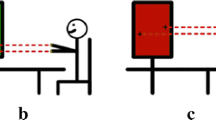Abstract
This study offers a psychological role that external representations can play in theprocess of refining intuitive ideas into scientific knowledge. An argument for thisrole is presented first through historical analysis of Galileo's ramp experiments andthen through documentation of an innovative sixth-grade classroom activity. In bothof these cases, engagement with and refinement of external representations of motionwere central supports to conceptual and empirical meaning making. An instructionalapproach that uses representation activities to support student development of theirown conceptual and empirical approaches to a phenomenon stands in contrast to theprevailing trend in science curricula, which focuses exclusively on content acquisition.
Similar content being viewed by others
References
diSessa, A.: 1993, ‘Toward an Epistemology of Physics’, Cognition and Instruction 10(2 & 3), 105–225.
diSessa, A., Hammer, D., Sherin, B. & Kolpakowski, T.: 1991, ‘Inventing Graphing: Meta-Representational Expertise in Children’, Journal of Mathematical Behavior 10, 117–160.
diSessa, A. A., Abelson, H. & Ploger, D.: 1991, ‘An Overview of Boxer’, The Journal of Mathematical Behavior 10(1), 3–16.
Drake, S.: 1975, ‘Free fall fromAlbert of Saxony to Honore Fabri’, Studies in History and Philosophy of Science 5, 347–366.
Drake, S.: 1978, Galileo at Work: His Scientific biography, University of Chicago Press, Chicago.
Galilei, G.: 1638/1974, Two New Sciences (S. Drake, Trans.), University of Wisconsin Press, Madison, WI.
Goodman, N.: 1976, Languages of Art: An Approach to a Theory of Symbols, Hackett Publishing Company, Inc, Indianapolis, IN.
Hall, R. & Rubin, A.: 1998, ‘...There's Five Little Notches in Here: Dilemmas in Teaching and Learning the Conventional Structure of Rate’, in J. Greeno & S. Goldman (eds), Thinking Practices in Mathematics and Science Learning, Erlbaum, Mahwah, N.J., pp. 189–235.
Kuhn, T. S. (ed.): 1977, The Essential Tension, University of Chicago Press, Chicago.
Lehrer, R., Schauble, L., Carpenter, S. & Penner, D.: 2000, ‘The Inter-Related Development of Inscriptions and Conceptual Understanding’, in P. Cobb, E. Yackel & K. McClain (eds), Symbolizing, Mathematizing, and Communicating: Perspectives on Discourse, Tools, and Instructional Design, Lawrence Erlbaum Associates, Mahwah, NJ.
Lehrer, R., Schauble, L. & Petrosino, A.: 2001, ‘Reconsidering the Role of Experiment in Science Education’, in K. Crowley, C. Schunn & T. Okada (eds.), Designing for Science: Implications from Everyday, Classroom, and Professional Settings, Lawrence Erlbaum Associates, Mahwah, N.J.
Monk, S.: 2001, Designing Representations of Motion: A Study of a Community of Practice in a 3rd/4th Grade Classroom, Cambridge, MA: TERC.
Naylor, R. H.: 1977, ‘Galileo's Theory of Motion: Processes of Conceptual Change in the Period 1604-1606’, Annals of Science 34, 365–392.
Nemirovsky, R., Tierney, C. & Wright, T.: 1998, ‘Body Motion and Graphing’, Cognition and Instruction 16, 119–172.
Oresme, N.: 1968, Nicole Oresme and the Medieval Geometry of Motions (M. Clagett, Trans.), University of Wisconsin Press, Madison, WI.
Roth, W.M.: 1994, ‘Mathematization of Experience in a Grade 8 Open-Inquiry Environment: An Introduction to the Representational Practices of Science’, Journal of Research in Science Teaching 31(3), 293–318.
Sfard, A.: 2000, ‘Symbolizing Mathematical Reality into Being-Or How Mathematical Discourse and Mathematical Objects Create Each Other’, in P. Cobb, E. Yackel & K. McClain (eds), Symbolizing and Communicating in Mathematics Classrooms: Perspectives on Discourse, Tools, and Instructional Design Erlbaum, Mahwah, NJ, pp. 37–98.
Takahashi, K.: 1993, ‘Galileo's Labyrinth: His Struggle for Finding a Way Out of His Erroneous Law of Natural Fall Part I’, Historial Scientiarum 2(3), 169–201.
Wisan, W. L.: 1974, ‘The New Science of Motion: A Study of Galileo's De Motu Locali’, Archive for History of Exact Sciences 13, 103–306.
Author information
Authors and Affiliations
Rights and permissions
About this article
Cite this article
Ford, M.J. Representing and Meaning in History and in Classrooms: Developing Symbols and Conceptual Organizations of Free-Fall Motion. Science & Education 12, 1–25 (2003). https://doi.org/10.1023/A:1022643003120
Issue Date:
DOI: https://doi.org/10.1023/A:1022643003120




